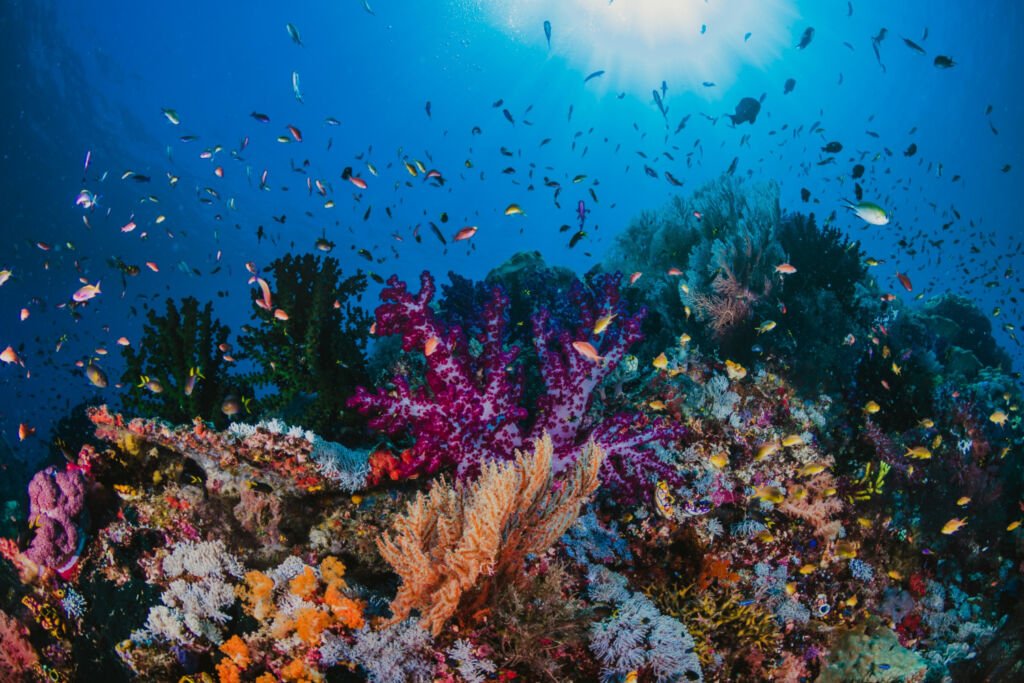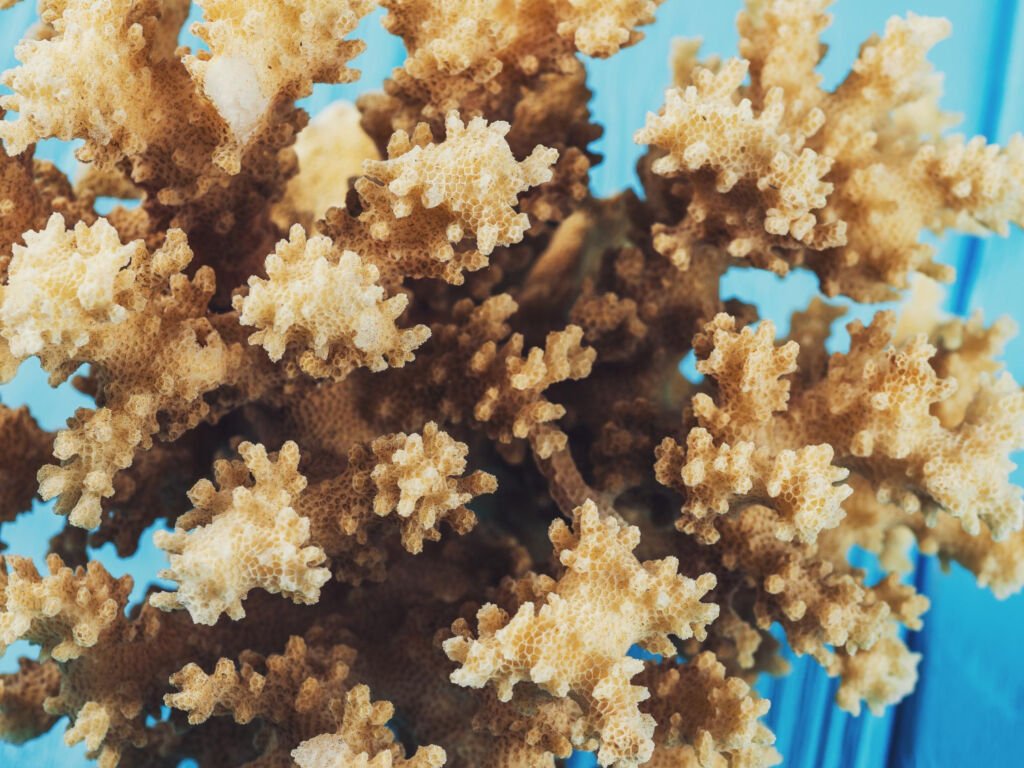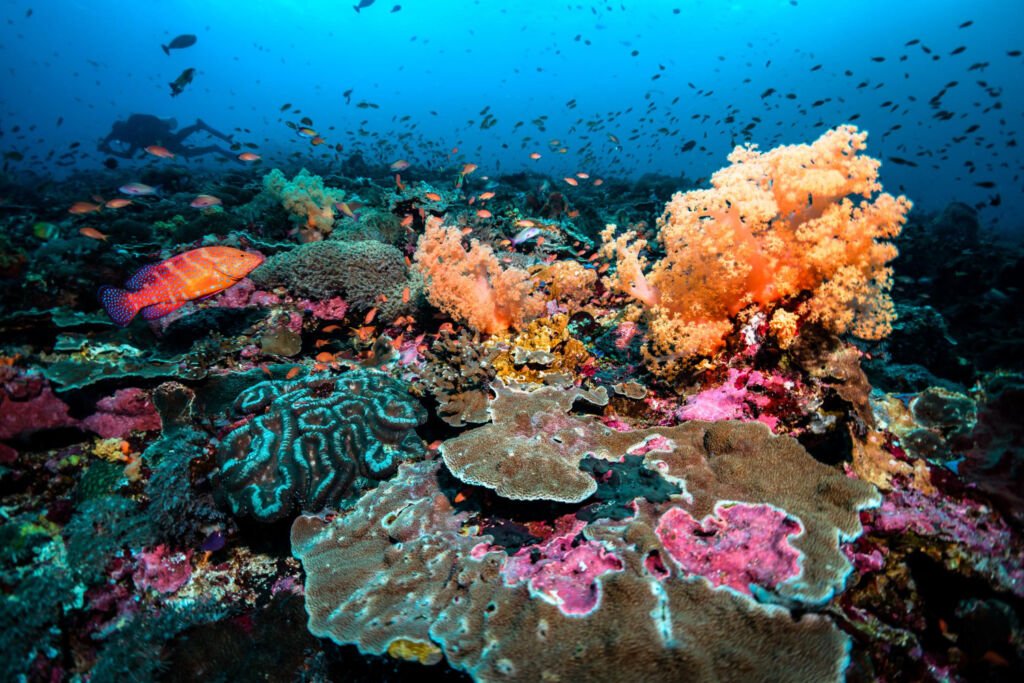Introduction:
Coral reefs may be celebrated for their dazzling beauty, but their value lies far beyond aesthetics. Beneath the shimmering surface of tropical waters, a battle rages unseen by most. These intricate ecosystems protect 200 million people from storms and wave erosion.
Despite this vital role, coral reefs are disappearing at an alarming rate. Studies show up to 50% of the world’s reefs have already been lost, putting coastal communities and marine biodiversity at extreme risk.
The threats are mounting, from rising temperatures to pollution, leaving the reefs and the coastlines they protect dangerously vulnerable.
How Coral Reefs Protect Coastlines:
1. Wave Energy Reduction:
- Coral reefs present a rough, complex underwater barrier. Think of them as a vast underwater obstacle course for waves. As waves crash against the reef, their energy is broken up and dispersed repeatedly.
- This friction caused by the coral structure dissipates a significant amount of the wave energy before it ever reaches the shore. Studies show reefs can reduce wave energy by up to 97%.
- Less powerful waves mean a significant reduction in coastal damage and erosion caused by the direct force of the waves.
2. Shoreline Stabilization:
- Reefs don’t just break wave energy; they also help build and stabilize coastlines. Live coral constantly generates new “skeleton” material (calcium carbonate), adding to the reef structure.
- Broken fragments of coral, along with sand and other debris, accumulate within the reef and on the shore, aiding in beach formation.
- Reefs work to trap and hold this sediment, preventing its loss to deeper water and maintaining beach volume to protect land areas better.
3. Storm Surge Defense:
- During storms, powerful surges carry destructive potential far inland. The same wave-breaking capabilities that protect shores daily also help mitigate the impacts of storm surges.
- Healthy reefs absorb a significant portion of the storm surge energy, acting as a protective buffer for coastal properties and infrastructure.
- This lessens the force of water flooding into coastal towns and villages, significantly reducing damage.
4. Ecological Importance:

- Biodiversity Hotspots: Coral reefs, known as the “rainforests of the sea,” hold immense biodiversity. Though covering less than 1% of the ocean floor, they harbor about 25% of all marine species.
- Essential Habitat & Food Source: Reefs provide homes, spawning grounds, and nurseries for countless marine creatures. Complex food webs depend on the health of the reef ecosystem.
- Supporting Healthy Fisheries: Fish populations thriving in reefs spill over into nearby waters, sustaining commercial and subsistence fishing industries.
5. Economic Importance:
- Coastal Protection: As outlined before, reefs provide invaluable shoreline protection, reducing the cost of building artificial defenses and lessening the economic losses from storm damage.
- Tourism and Recreation: Healthy reefs are vibrant tourism magnets, supporting millions of jobs and injecting massive income into local economies through diving, snorkeling, and other reef-related activities.
- Medicine and Bioproducts: Coral reef organisms possess unique compounds with potential for developing treatments for cancer, infections, and other diseases.
6. Cultural Importance:
Integral to Coastal Communities: Reefs shape the livelihoods, traditions, and spiritual beliefs of many coastal communities worldwide. They provide sustenance and protection and are deeply intertwined with cultural practices.
Threats to Coral Reefs and Coastal Protection:
1. Climate Change:
- Rising Ocean Temperatures: Corals exist in a delicate temperature range. Increases as small as 1-2 degrees Celsius above normal can trigger coral bleaching.
- During bleaching, corals expel the symbiotic algae that give them color and provide energy.
- Prolonged bleaching leads to coral death, which, in turn, contributes to the breakdown of the reef’s physical structure.

- Ocean Acidification: As the ocean absorbs excess carbon dioxide from the atmosphere, its pH decreases, becoming more acidic. This makes it harder for corals to build their calcium carbonate skeletons.
- Weaker skeletons are more vulnerable to erosion and breakage, undermining the structural integrity of the reef and, thus, its protection capabilities.
2. Pollution and Coastal Development:
- Nutrient and Sediment Pollution: Runoff from agriculture, deforestation, and improper sewage treatment can dump excess nutrients and sediments into coastal waters.
- These smother corals block sunlight needed for photosynthesis and fuel the growth of harmful algae that outcompete corals.
- Overfishing: Removing too many fish, especially herbivores, disrupts the balance of the reef ecosystem.
- This can lead to overgrowth of algae that harms corals. Large-scale destructive fishing practices like blast fishing directly decimates the physical reef structure.
- Unsustainable Coastal Development: Constructing coastal infrastructure, dredging, and reclamation often involve destroying reefs or releasing damaging pollution.
- Removing shoreline protectors like mangroves further increases coastal vulnerability by exacerbating erosion.
- Destructive Fishing Practices: Methods like dynamite and cyanide fishing devastate the reef’s physical structure.
How to Protect the Coral Reefs:
1. Global & Policy-Level Actions:
- Combatting Climate Change: Drastically reducing greenhouse gas emissions is paramount to protect reefs from rising temperatures and ocean acidification. This requires shifting to renewable energy, energy efficiency, and sustainable global practices.
- Marine Protected Areas (MPAs): Designating areas where fishing, development, and other harmful activities are restricted allows reefs to recover and build resilience. Well-managed MPAs are invaluable for reef conservation.
- Enforcing Sustainable Fishing: Regulations on fishing gear, catch limits, and protecting species crucial to the reef ecosystem help minimize the impact of overfishing on these environments.
- Regulating Pollution and Coastal Development: Stricter regulations and enforcement prevent industrial runoff, coastal destruction, and improper sewage disposal to lessen the direct burdens on reef ecosystems.
2. Individual Actions:
- Responsible Tourism: Choosing reef-conscious tour operators, snorkeling or diving without touching corals, and avoiding harmful products (like some sunscreens) reduce tourism’s negative impact.
- Reducing Carbon Footprint: Daily choices that lessen your carbon footprint (conserving energy, mindful transportation, sustainable diets) indirectly benefit reefs by helping to combat climate change.
- Supporting Conservation Organizations: Donating or volunteering with organizations dedicated to reef research, protection, and restoration makes your voice and contributions count.
- Staying Informed and Spreading Awareness: Learning about reefs, their importance and their threats empowers you to share that knowledge within your circles, building more comprehensive support for their protection.

3. International Agreements to Protect Coral Reefs:
- Convention on Biological Diversity (CBD): A cornerstone of global biodiversity conservation efforts, the CBD promotes sustainable use of resources and aims to safeguard and share the benefits of genetic resources. It has led to a specific focus on marine and coastal biodiversity, including coral reefs.
- United Nations Framework Convention on Climate Change (UNFCCC): Central to international action on climate change, the UNFCCC recognizes the vulnerability of coral reefs to rising sea temperatures and ocean acidification. Measures taken under this agreement to reduce greenhouse gas emissions are vital to the long-term survival of reefs.
- Convention on International Trade in Endangered Species of Wild Fauna and Flora (CITES): CITES regulates international trade in threatened species, including many hard coral species. It aims to prevent trade-driven overexploitation that further strains coral reefs.
- Ramsar Convention on Wetlands: While not exclusively focused on coral reefs, Ramsar’s mandate to protect wetlands of international importance extends to mangrove forests and seagrass beds that are often closely linked with coral reef ecosystems. Their protection supports overall coastal and reef health.
- International Coral Reef Initiative (ICRI): ICRI is a unique multilateral partnership among nations, international organizations, and NGOs focused solely on coral reef conservation. While not strictly an agreement, it fosters global cooperation, information sharing, and setting action targets to address reef threats.
Many of these agreements have broader mandates, and coral reef protection is one aspect of their implementation.
The effectiveness of any agreement depends heavily on how successfully individual nations enact and enforce the measures on the ground.
Regional agreements and local management mechanisms also play a crucial role in tailoring reef protection strategies to local circumstances.
Conclusion:
Coral reefs, our dazzling coastal guardians, send a distress signal we can no longer ignore. Composed of pollution and unsustainable practices, climate change pushes these life-giving ecosystems to the brink. The time for admiring their beauty is over; now is the time for decisive action.
The fate of coral reefs lies not just in the hands of governments or scientists but in our choices. Protecting reefs means protecting our coastlines, livelihoods, and a precious piece of our planet’s natural heritage.
Supporting regulations that shield reefs, demanding change from industries that harm them, and altering our daily habits to lessen our impact– these collective actions can shift the tide. Rebuilding reef resilience is a project demanding our participation.

